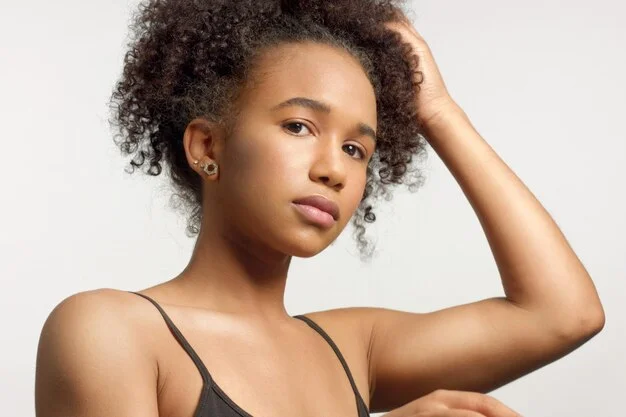You’re not alone if you’re dealing with sagging skin or dark spots. These are some of the most common effects of aging and sun exposure.
Potenza RF microneedling offers a non-surgical solution to both saggy skin and hyperpigmentation. It works by encouraging your skin to heal itself, improving tone and firmness while reducing the signs of damage.
This article explores how RF microneedling can address these skin concerns, diving into its benefits, process, and the results you can expect.
Before we get into how awesome Potenza Rf microneedling is for treating hyperpigmentation and saggy skin (skin laxity),
You’d be pleased to know that our physician-led medical aesthetics clinic in Limoges offers Potenza treatment for a variety of skin concerns, and for all skin tones –
Book an appointment today!
We’d love to meet, and help you achieve your skin goals
RF Microneedling In A Nutshell…
RF microneedling combines two skin-rejuvenation technologies—radio frequency (RF) energy and microneedling.
The treatment uses ultrafine needles to create micro-injuries in the skin while simultaneously delivering RF energy deep into the dermis.
This dual action stimulates the production of collagen and elastin, two proteins that maintain your skin’s firmness and elasticity.
Read more about Potenza RF microneedling here:
What is Potenza RF Microneedling: The Secret To Flawless Skin
What Causes Hyperpigmentation ?
Hyperpigmentation happens when the skin produces too much melanin, the pigment that gives colour to your skin, hair, and eyes. This can happen for several reasons, and it often leaves the skin looking uneven or marked with dark patches.
When the skin is exposed to sunlight, particularly UV rays, melanin production can go into overdrive. This leads to the formation of dark spots or patches. Hormonal changes can also play a big role. For example, melasma—those dark patches that commonly appear during pregnancy or menopause—is often linked to shifts in hormone levels.
As we get older, the number of melanin-producing cells decreases, but the ones that remain can become more active, creating those familiar age spots. Even skin injuries like acne, cuts, burns, or dermatitis can lead to darker marks during the healing process.
Other contributors include stress and certain medications, such as antibiotics or hormonal birth control, which can also trigger an increase in melanin production. Hyperpigmentation is a reflection of how both internal and external factors can affect the skin’s appearance over time.
All you need to know about sunburns: Understanding Sunburn: Types, Risks, Prevention and Treatment
How Does RF Microneedling Treat Hyperpigmentation?
RF microneedling targets hyperpigmentation in several ways. The tiny microchannels created during treatment allow the radiofrequency energy to penetrate deeply, breaking down areas of excess melanin that cause dark spots.
Over time, the body naturally sheds these pigmented cells, leading to a more even complexion. In addition, the treatment stimulates the production of new skin cells with balanced melanin levels, reducing the likelihood of recurring discoloration.
Studies suggest that RF microneedling can be particularly helpful for stubborn pigmentation, such as melasma, when used in combination with other treatments like topical skin-lightening agents or laser therapy.
The microchannels created by the needles enhance the absorption of these products, allowing them to work more effectively within the deeper layers of the skin.
What Causes Saggy Skin
Saggy skin happens when the skin’s elasticity and ability to snap back are compromised otherwise known as skin laxity.
This can occur due to aging, weight loss, or other factors. Aging is the most common cause, as the body produces less collagen and elastin over time—two proteins maintaining firmness and structure.
External factors like sun exposure, pollution, and smoking can accelerate the breakdown of these proteins, making sagging more noticeable.
Significant weight loss can also lead to loose skin, especially when the skin has been stretched for a long time or the weight loss happens rapidly, as with bariatric surgery.
Pregnancy is another common contributor, with the skin around the abdomen often struggling to return to its pre-pregnancy state, especially in women carrying multiples.
Medical conditions like granulomatous slack skin and Ehlers-Danlos syndrome can also cause sagging by affecting collagen production or weakening connective tissues.
Lifestyle choices such as smoking and poor nutrition further diminish collagen and elastin levels, exacerbating the problem.
Check out this article: laser hair removal during pregnancy- Is it safe?
RF Microneedling for Sagging Skin
The effects of RF microneedling on sagging skin are equally impressive. By delivering radiofrequency energy into the deeper layers of the skin, the treatment stimulates collagen and elastin production, which helps to tighten and lift the skin over time.
This can reduce the appearance of sagging around the jawline, cheeks/ jowl, and neck, as well as improve skin texture and firmness across the treated areas.
Unlike invasive procedures like surgical facelifts, RF microneedling offers a non-surgical approach with minimal downtime. Over the course of several sessions, patients can expect a gradual improvement in skin elasticity and tightness, resulting in a more youthful and rejuvenated appearance.
Comparing RF Microneedling To Other Treatments For Hyperpigmentation and Saggy Skin?
When it comes to treating hyperpigmentation and saggy skin, Potenza RF microneedling stands out as a superior option due to its advanced technology and versatility.
Unlike topical creams, which require long-term use to deliver mild results, or chemical peels, which may cause downtime and irritation, Potenza combines microneedling with radiofrequency energy to directly stimulate collagen and elastin production.
This dual-action approach not only improves skin texture and firmness but also addresses uneven pigmentation more effectively by encouraging skin regeneration from within.
Related: RF Microneedling and Chemical Peel: 10 Reasons They’re Skin’s BFFs
And if laser therapy isn’t your thing for reasons such as your skin tone, Potenza RF microneedling is safe for all skin tones, particularly for individuals with darker complexions, who may be at higher risk of post-inflammatory hyperpigmentation with lasers.
Additionally, while lasers often target melanin deposits directly, Potenza works by remodeling the deeper layers of the skin, offering longer-lasting results without the risk of surface damage.
Potenza’s versatility is another major advantage. It doesn’t just treat hyperpigmentation and saggy skin—it’s also effective for fine lines, wrinkles, stretch marks, and acne scars, making it an all-in-one solution for comprehensive skin rejuvenation.
Moreover, the minimal downtime means you can quickly return to your routine, experiencing natural-looking results as your skin gradually heals and tightens.
Related:
Botox After Microneedling: 5 Key Benefits You Need to Know
Is RF Microneedling Better Than Microneedling For Glowing Skin?
How Long Does It Take To See Results?
The Potenza RF microneedling treatment utilizes ultrafine needles and heat to penetrate the top layer of the skin, triggering the natural healing process to generate new collagen and elastin.
The time it takes to see results varies from person to person and depends on factors like the number of passes and penetration depth during treatment.
Typically, elastin and collagen building occur around 4-6 weeks after treatment, with optimal results appearing around 12 weeks after the last session.
The Fusion Tip, equipped with a dual-air chamber, enhances skin penetration of topicals by 67%.
Operating in monopolar mode at 1 MHz, it delivers deep and wide RF energy, enhancing tissue engagement and topical penetration.
While a treatment plan of three to five sessions, spaced roughly four to six weeks apart, is recommended, some patients may notice improvements after the first or second session, with continued enhancements visible six to 12 months post-treatment.
The Ideal Candidate for Radiofrequency Microneedling
Radiofrequency microneedling is generally safe but that doesn’t mean it is suitable for everyone.
Ideal candidates are healthy, show early signs of aging, and have realistic expectations. However, the treatment is not recommended for individuals who have recently used Accutane, are experiencing an active cold sore, have a skin infection, or suffer from moderate to severe skin conditions like psoriasis.
It is also contraindicated for pregnant women, individuals undergoing chemotherapy or radiation therapy, those taking anticoagulants, or those with a history of keloids, hypertrophic scarring, or poor wound healing.
For individuals in their 50s, 60s, and beyond, RF microneedling can effectively improve skin texture, firmness, and elasticity. However, those with significant skin laxity may achieve better results by combining it with complementary treatments like PDO thread lifts or laser resurfacing.
Post-Treatment Care Guidelines
After your Potenza™ RF Microneedling treatment, it’s crucial to follow specific guidelines to ensure optimal results and minimize side effects.
First 24 Hours:
During the initial 24 hours post-treatment:
- Avoid direct heat and sweat, including steam rooms, saunas, and exercising.
- Refrain from applying makeup to the treated area.
For at Least Three Days After Treatment:
- Avoid topical irritants such as harsh soaps, medicated washes, scrubs, oils, retinol, and scented lotions.
- Opt for cool water and gentle soap when bathing, and pat skin dry with a clean, soft towel.
- Refrain from scrubbing, scratching, or shaving.
- Moisturize with over-the-counter hydrocortisone 1% mixed with either aloe, Vaseline®, or Aquaphor®, up to three times daily or as needed to reduce irritation or itching.
For Up to Two Weeks After Treatment:
Over the following two weeks:
- Avoid direct sun exposure and tanning beds.
- Apply sunscreen SPF 30+ daily and wear protective clothing, hats, and sunglasses when outdoors.
Treatment Timeline
Here’s what you can expect during the treatment timeline:
Immediately After
- Experience mild to moderate redness, swelling, sensitivity, and pinpoint bleeding in the treated area.
Up to 72 Hours After
- Notice a reduction in initial redness, swelling, and sensitivity.
- Micro-scabbing may form, which feels mildly rough in texture.
4-6 Weeks After
- See a resolution of side effects as micro-scabs naturally slough off.
- Notice firmer, smoother, and healthier-looking skin.
- Experience ongoing elastin and collagen production deep within the skin.
6 Months After
- Achieve maximum skin rejuvenation results.
- Notice tighter, smoother, and more youthful-looking skin.
With Each Subsequent Treatment:
- Experience continual elastin and collagen growth for natural skin rejuvenation.
- Observe a reduction in early signs of aging, such as fine lines and tissue laxity.
- See improvement in overall skin health for a more youthful, smooth, and contoured appearance.
Managing Common Side Effects
If you experience common side effects:
- Apply over-the-counter hydrocortisone 1% mixed with either Vaseline® or Aquaphor®.
- Use cold packs wrapped in a towel to reduce redness and swelling.
- Avoid scratching or picking at the treated area.
Following these guidelines and understanding the treatment timeline can help you achieve and maintain optimal results from your Potenza™ RF Microneedling treatment.
Related: Does RF Microneedling Burn (Facial) Fat?
In Conclusion…
Dealing with dark spots or sagging skin can be frustrating, especially when creams and serums don’t seem to do enough. But here’s the good news—your skin has the ability to heal and renew itself, and Potenza RF microneedling helps speed up that process.
By stimulating collagen and breaking down excess pigmentation, it works with your body to reveal smoother, firmer, and more even-toned skin over time.
Everyone’s skin journey is unique, and finding the right treatment can make all the difference. If you’re ready to take that next step, we’re here to help.
Book an appointment at our physician-led clinic in Limoges, and let’s create a plan that’s tailored to your skin’s needs. You deserve to feel great in your own skin!
Quick Links

Dr. Lian Peter, MD, MPH, CCFP, is a Family physician with a passion for aesthetics. In her aesthetic clinic, she provides a wide range of minimally invasive and non-invasive procedures, constantly honing her skills to deliver exceptional care and help patients attain their desired appearance.






